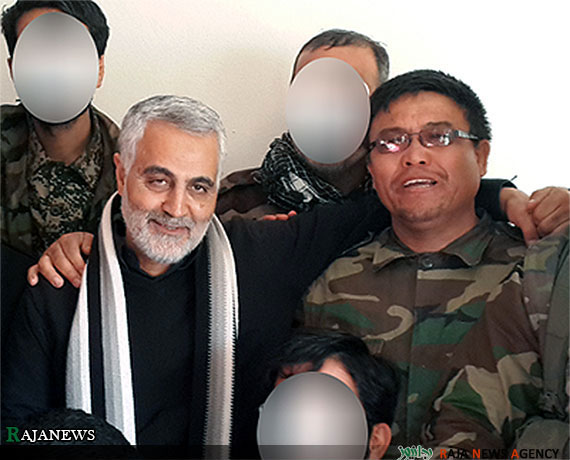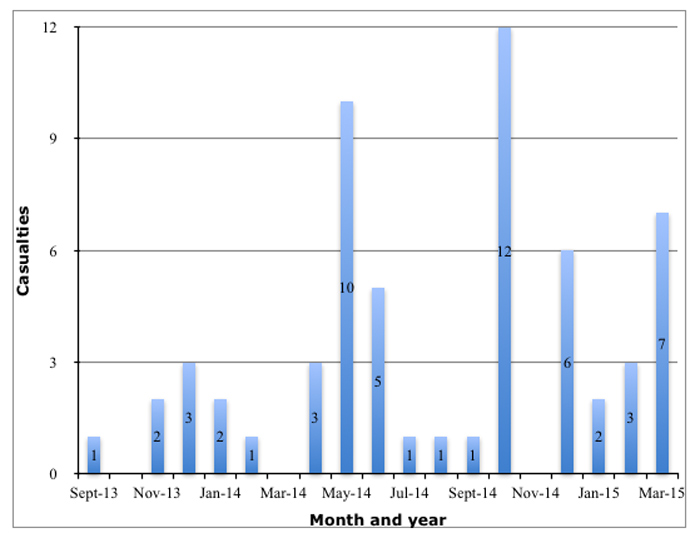 Qods Force commander Major General Qassem Soleimani, and former Fatemiyoun Brigade commander Ali-Reza Tavasoli, who was later killed in combat in Syria.
Qods Force commander Major General Qassem Soleimani, and former Fatemiyoun Brigade commander Ali-Reza Tavasoli, who was later killed in combat in Syria.
The civil war in Syria risks exacerbating the sectarian and ethnic conflicts in geographically distant Afghanistan and Pakistan. The deaths of 62 Shiite Afghan nationals killed in combat in Syria since September 2013 testifies to that threat: there is every reason to expect surviving Shiite Afghan veterans of the civil war in Syria to relocate to Afghanistan and Pakistan to fight Sunni groups, including the Afghan and Pakistani Taliban, some of whose members also are present in Syria.
The 62 individuals were identified through a survey of Iranian media coverage of the funerals of Shiite Afghan nationals killed in combat in Syria. They were all members of the Fatemiyoun Brigade, which, according to the Islamic Republic media was “established in Kabul by Afghan Shiites.” However, all individuals analyzed were buried in different cities in Iran, their families were present in the funeral processions, and the photos clearly indicate that the “martyrs” were well known figures in the cities where the processions took place. This suggests Fatemiyoun Brigade combatants were recruited among Afghan refugees in Iran rather than in Kabul, Afghanistan. The presence of Martyr Foundation [Bonyad-e Shahid] representatives at the funeral services and compensation of the families by Islamic Republic authorities provide additional proof of official recruitment of the Afghan combatants.
In “Moalem,” [The Teacher] a propaganda movie glorifying the role of the Fatemiyoun Brigade, the anonymous narrator describes the desire among the Shiite Afghans to defend Shiite pilgrimage sites around Damascus and fight radical Sunnis, including the Afghan Taliban, as the primary motive behind their presence in Syria. However, a photo of the late Fatemiyoun Brigade chief commander Ali-Reza Tavasoli, also known as Yasini and Abu Hamed, with Major General Qassem Soleimani, chief commander of the extraterritorial operations Qods Force of the Islamic Revolutionary Guards Corps (IRGC QF), indicates the Fatemiyoun Brigade is a unit within the organizational structure of the Qods Force. The presence of Brigadier General Esmaeil Qaani, Qods Force’s second-in-command, at the funeral services of some of the Afghan martyrs provides further evidence of the connection. The Fatemiyoun Brigade must therefore be seen as a small part of the IRGC QF’s operations against Tehran’s regional adversaries.
The deceased Tavasoli and his deputy, the late Reza Bakhshi, also known as Fateh – the only individuals in the study whose ranks are known – were both Afghans, and the IRGC does not seem to have imposed Iranian commanders upon the Afghans in the field.
Afghan nationals also seem to be fighting separately from Qods Force units. As shown in chart 1, the Fatemiyoun Brigade suffered the largest casualties in the course of four distinct operations: May/June 2014, October 2014, December 2014 and March 2015. A yet unfinished study by this author comparing the dates of death of Shiite Afghan nationals with those of Iranian and Lebanese nationals killed in Syria tentatively concludes that each nationality suffered losses at a different time. This may be due to the Qods Force’s attempts at compartmentalization along national and language barriers.
Very little information is available about the specific operations in which the Fatemiyoun Brigade engages, but according to one source, the unit suffered significant casualties during the Syrian military’s initial takeover and later withdrawal from Dokhaniyeh, east of Damascus, in October 2014. The same source also reports a Fatemiyoun Brigade engagement during an unsuccessful Syrian Army offensive against Aleppo, which possibly took place in February 2015.
Syria’s sectarian conflict has rekindled old tensions between Islam’s two largest denominations and has further destabilized the Middle East since the Arab Spring. Its spillover effects have already thrust Iraq and Lebanon to the edge of new civil wars. Qods Force’s recruitment of Afghan refugees in it’s sectarian conflict against regional Sunni governments will likely exacerbate existing ethnic and sectarian conflicts in Afghanistan and Pakistan. With the departure of the international military presence, Afghanistan too may become a proxy battlefield between Shiite Iran and a Sunni coalition of Saudi Arabia, Pakistan, the Taliban, and affiliated salafist jihadist groups.
Ali Alfoneh is a senior fellow at Foundation for Defense of Democracies. The author thanks Mr. Ahmad Majidyar for valuable comments.
Chart 1: Shi’a Afghan nationals killed in Syria September 2013-March 2015
∗ Two Shi’a Afghan national killed in combat in Syria were exempted from this chart since the time of their death was not known.









3 Comments
SOHR has also reported Afghans fighting alongside SAA in Aleppo.
http://syriahr.com/en/2015/03/violent-explosion-heard-in-aleppo-and-the-clashes-continue-in-the-city-of-aleppo-and-its-countryside/
One example, but they’ve been there throughout the Aleppo offensive. Rumor has it that foreign troops, including Afghans, made up a large part of the initial assault that sought to cut off the salient last month.
Yes James. The communists are in control, Jesus is returning any day now, Israel is in mortal danger and Martians have been sighted flying over the Pentagon.
Back on planet Earth, I have to say this actually could be good news. No one wants another crazy group of Islamic fundamentalists running around that part of the world. However, as long as these Shia groups don’t start making and executing threats against the West they may actually prove to be a useful counterweight against the Taliban. Western soldiers have been there for going on 14 years now and we still haven’t defeated the Talibs. Eventually a local force is going to have to step up and confront the Taliban. I seriously doubt the joke of a government that runs Afghanistan will be up to the task. Maybe groups like these will do it instead. Yes, Iran will gain more influence in Afghanistan as a result, but if that means no more planes flying into buildings that’s not that big of a deal for me. Iran’s beef is mostly with Israel rather than the West, and if we can work together with Iran to beat ISIS and the Taliban we may find this decades old Iran paranoia is no longer a relevant concern.
too bad the Shia don’t have a ‘couple’ of locales of consequence in Pakistan, then maybe ‘we’d’ see them taking some of their angst out on the Sunni Extremist’s lounging about Pakistan